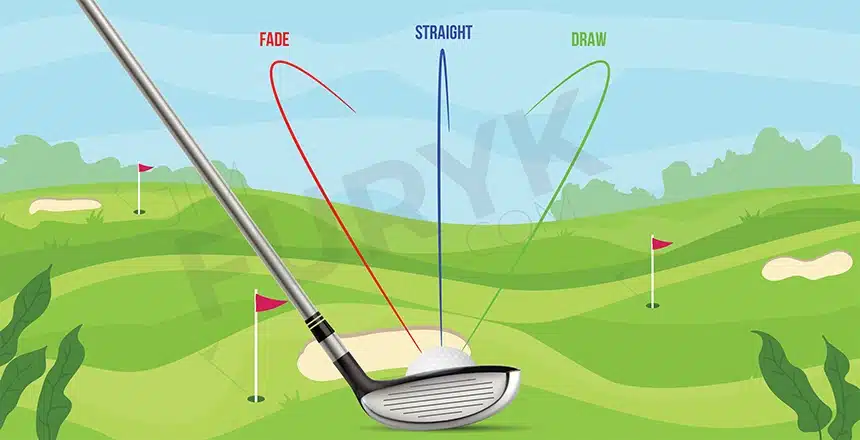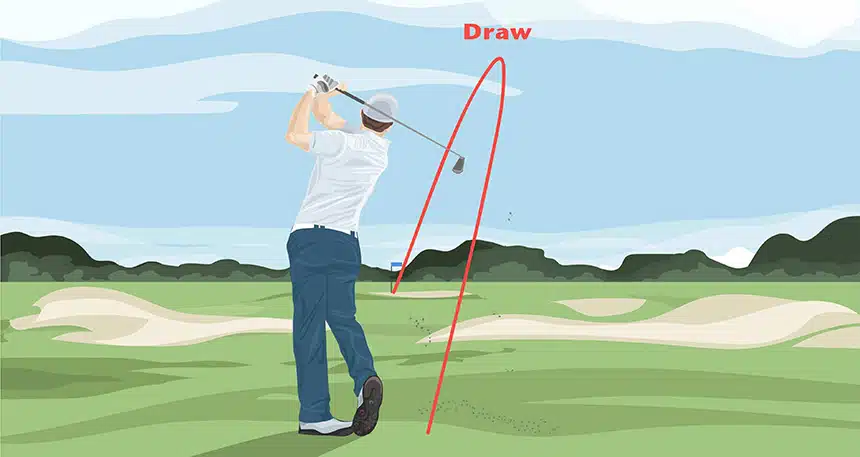How to hit a draw in golf? Meaning how to get the golf ball trajectory or flight path to start from the right and curve to the left, or left to right for left-handed golfers. Draw shots, unlike hook shots, are not produced accidentally. They’re purposely hit in order to avoid an obstacle in the way of your target.
With a draw, you can get the golf ball to reach the target despite not hitting it straight. How amazing is that!
Although actually controlling the ball flight this way is no easy task. But understanding how it all works is, which will make your practice sessions more productive. And even more so when using Swing Align. So let’s find out what that is, along with how to go about hitting a draw when playing golf!
What Does ‘Draw’ Mean In Golf?

When the ball flight curves, in a more controlled manner, from the right side to the left side, a draw is produced. But this ball flight will be left-to-right if you’re a left-handed golfer.
Now, when the shot travels too quickly, far, or uncontrollably from the right to the left, it’s a hook and not a draw.
A draw shot i.e. right-to-left ball flight stands in stark contrast to a left-to-right ball flight, where the latter is known as a fade in golf. With that in place, the opposite of an extreme right-to-left curve of the golf ball i.e. a hook is an extreme left-to-right flight path, correct? And this is what we call a slice.
Therefore, fade and draw shots are controlled and well-intended when you want to aim that way, whereas slices and hooks are wayward or mis-hit shots that do you or your round of golf no good.
In This Post
What Causes A Draw In the Game of Golf?
Hitting a draw is often the result of a closed clubface angle at impact. When your golf club path or swing direction is out toward the right, the face angle will be closed on impact. The unavoidable outcome of which is hooking or drawing the ball.
Under these circumstances, and/or when the golf ball is positioned too behind in the stance (the basics of a proper golf setup), your shot launches toward the right of your target, coupled with negative spin responsible for curving the ball toward the left during flight. Hitting down on that golf ball does mess with trajectory indeed.
How to Hit A Draw In Golf With Driver
You may be using one of these best drivers for distance or even one of the best drivers ever, but if you don’t understand the fundamental rule of the swing that actually creates a right-to-left or left-to-right ball flight, no consistency can be established.
You should also know that a driver has the longest shaft length in every complete golf club set. And it’s got the lowest loft, which makes clubface direction/angle control even more difficult. However, you can override it all in the sense that you can learn how to make your drives curve a certain way with more control.
1. It’s All About Controlling the Clubface!
Since the cause of a draw is a closed clubface, you should be aiming for just that. Try to not open that driver clubface too much through the golf swing. Because an open clubface will not square at impact, rather it produces excessive sidespin. And that means excessive curve, thus leading to a slice.
So the clubface absolutely must square on impact where your club path takes on a subtle inside-to-square movement.
The next thing to talk about is your grip, which should involve placing the top hand at the top with the bottom one square and slightly below the club. You know you’re doing it right when your forefinger and thumb form a ‘V’ shape pointing at the trail shoulder. If that’s not happening, it means you may have to strengthen the grip.
If you check out this complete guide for the correct golf grip, you’ll understand that “strengthening” here doesn’t mean increasing grip pressure. Rather you have to slightly rotate the hands clockwise, and this applies to the right-hand orientation of course.
Keeping the Clubface Square At Impact
Once again, square the clubface during the backswing and through impact. Keep the clubface pointing at your golf ball for the longest time on your takeaway. This means rotating your club back using your body and arms, and not the hands.
Pay attention to your hitting position at the highest point of your golf swing – wrist flat on the top hand, in line with the forearm instead of bending, bowing, or cupping too much.
2. Making Proper Use of Your Hips
During rotation, you should be turning the body into that trail hip. At this point, feel the weight on your back leg. More specifically, on the heel and inside of your trail or back foot.
The trail hip turns away from that golf ball while your posture and spine take on a steady, strong position. Hence, allowing you to turn aggressively into the ball and letting the arms return back to the position that approaches the golf ball more from the inside rather than moving out.
3. Swinging Inside-to-Out
It’s quite simple, although easier said than done.
An inside-to-out swing path comes about only when you square the clubface and rotate back properly. This is actually an inside-to-square golf club path, which creates the spin required at the moment of impact to get the ball to draw.
4. Finishing Strong and Staying Connected
Your follow-through is supposed to be aggressive if you wish to strike a draw. Do not slow down into follow-through and into the golf ball. Oftentimes, golfers end up doing that by extension, and that tends to change or mess with swing path or clubface angle.
Keep in mind that you should be driving through till the finish – rotate the chest so it faces your target.
Also bear in mind that your body and arms must stay connected during the entire swing. This is where you use those big muscles, not just your hands and arms.
How to Hit A Draw With Irons
It’s much the same as how to hit a draw with a driver, except for a few changes in your golf swing.
1. Shorter Swing
Be it the best taylormade irons, Callaway irons, or Mizuno irons, the norm is that irons have a shorter shaft length (here, check out the standard shaft length of golf clubs) in comparison to drivers. Thus, it’s easier to control irons. And when clubs are shorter, your swing also ought to be shorter.
So instead of controlling your golf club with the hands and arms, make sure you’re focusing on, using your body, rotating back. The goal here is to ultimately create enough space through rotating forward and creating that necessary inside-to-out path. This way, you end up attacking the inside of that ball.
You Should Be Rotating, Not Swaying
If you lose balance when hitting your irons, you won’t be able to alter golf ball flight. When playing irons, shorter in length than a driver, your swing becomes shorter. With that in mind, on your way back, rotate against the hold of the trail leg. And then returning to the golf ball through lower body rotation, let your club move inside-out, then down the target line.
With irons, since they’re heavier in comparison to the driver, you need to allow the extra weight to rotate you till the end facing your target.
2. No Hand Flipping
Hitting a draw can also mean preventing a slice. However, there are many golfers who still flip the hand on impact, which closes the clubface and leads to a hooked shot. So make it a point to control that rotation, so you can square the angle of the clubface with the body and not the hands.
Hit A Draw Every Time With ‘Swing Align’
It’s easy to get the ball flight to curve slightly from right to left with this hugely popular tool called Swing Align. It boosts confidence during practice sessions through instant feedback, which will and does reflect during your round of golf.
With Swing Align aid, you can achieve more consistency as it allows you to control the angle/orientation of the clubface with better rotation and balance in your swing.
- Place the ground alignment stick at the feet and place the Swing Align tool across your chest and arms.
- A square setup is needed of course where the shoulders aren’t pointing toward the left of the target (you can’t hit draw shots like that).
- Your golf swing should be more controlled – feel like you’re rotating back and, at the same time, maintaining a steady spine angle and also controlling that clubface.
- Your Swing Align rod is moving down on the takeaway part of the golf swing. Rotate down and then through to get the alignment aid’s trail end to move down. And this is when the device lets you know if full rotation has taken place back and through your swing plane.
If the Swing Align tool leading end raises on your backswing, the downswing will be marked by an outside-to-in path, hence producing a slice.
Difference Between Draw and Fade

A draw is when the golf ball begins its flight from the right, but lands up on the left. Draws and hooks are pretty much the same, except that hooked shots have a more extreme, uncontrolled curve.
On the other hand, there’s fade. How to hit a fade consists of opening your stance and clubface. Whereas hitting a draw requires you to close the clubface at impact. A draw goes from right to left, while a fade has a left-to-right ball flight.
Difference Between Draw and Hook
Both draws and hooks come about as a result of a closed clubface, but there’s more to this.
A draw shot can be easily hit when your stance is open, and clubface closed of course. While a hook is caused when both your stance and clubface are closed. The former produces controlled ball flight as opposed to the erratic, unintended right-to-left path of hooked shots.
The Bottom Line – Draws Can Avoid Obstacles!
When hitting a draw becomes easier, you can actually go around obstacles during your round of golf. It’s only common and natural to hit your shots straight, but a straight flight path is not what you need when your golf ball is confronted with an obstacle. To hit a draw ultimately means to keep the clubface pointing in the direction of your target at setup. Your shoulders, hips, and feet must face to the right as well. More so than that clubface, so it closes through impact and gives rise to a right-to-left trajectory.

